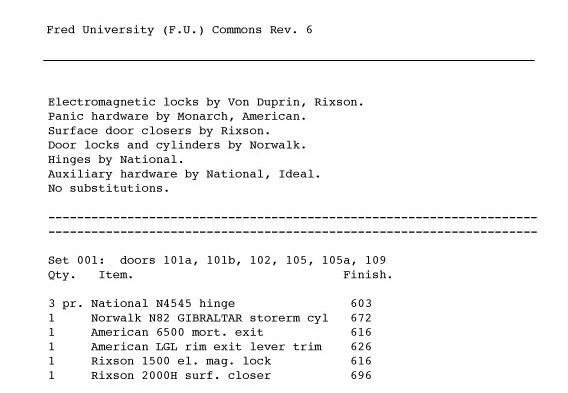If you are a door hardware professional you’ve seen them: the stupid specification, the dumb door schedule and the hardware take-off from hell. If I had a penny for every dollar I’ve saved customers by debunking bad specs, I’d probably be a gazillionaire today.
Where do they come from? There are a couple of sources. One is software problems – i.e. bad software or architects who don’t know how to use their software. Another is ignorant or incompetent architects. A third is inept or misinformed hardware consultants. However, what really allows the bad hardware spec to go forward is lack of communication.
Dysfunctional Software, Architect or Industry?
I was working with a systems integration company on delayed egress systems for schools in St. Louis. The salesman from the integrator sent me the door schedule from the architect and right away I noticed that there were two electromagnetic locks on each door. “This spec won’t work,” I said to myself, but when I called the salesman, he replied in the typical attention-deficit manner of many salesmen, “Listen, I don’t care, just price it out and send me the quote. The bid goes up in an hour.”
Since Murphy’s Law was written by a locksmith named Murphy with the hardware industry in mind, this fool of a salesman won the bid and the project manager and I were left to figure out what the architect may have meant. I spent some time trying to devise a system of relays that would allow the redundant locks specified for every door to work together more or less in compliance with life safety and building codes, but the more I tried to make the cockamamie conglomeration of hardware fit the application, the more I realized I needed to speak to the architect and find out what he had in mind.
Perhaps because the project manager was afraid that my company – a hardware distribution company – would sell to his customer direct, he would not give me the architect’s contact info. Luckily, as I had him fax me more and more documents to try to figure the spec out, he finally sent me one with the contact info on it by accident.
When I called the architect it turned out that the new software he was using did not delete the old hardware when he added the new hardware. Half the hardware was on the spec by accident. After the architect removed the redundant hardware (with a little help from me) the spec was rewritten and the job went forward with few problems, all because of a little communication.
Electrifying
A project manager called me to get a quote on about twenty fail safe electric strikes. He said that he needed fail safe because the doors needed to be unlocked in the event of a fire to comply with life safety code. So, naturally, I asked the obvious question: “Are these fire doors?”
“Yes, they are,” he replied.
“Then the strikes must be fail secure, not fail safe,” I said.
“But they can’t,” he countered. “The Fire Marshall said they had to be unlocked if the fire alarm went off.”
“Ah,” I said. “Are these stairwell doors?”
“Yes!” he said. “They are all stairwell doors.”
Of course, stairwell doors are fire rated because a stairwell tends to become a chimney in a fire. So they must remain positively latched. Yet, because they are stairwell doors, life safety code dictates that at least some of them (it varies by locality) must be also unlocked.
There are two ways to lock a fire door so that it is both positively latched and unlocked in the event of a fire emergency. It can be done with an electric lock or with an electromagnetic lock; it cannot be done with an electric strike because an electric strike works by releasing the latch bolt of the lock. If the latch bolt is released, the door is not positively latched.
In this small conversation I may have saved the project manager’s company several thousand dollars or maybe more. If, for example, I had asked no questions, but simply quoted and subsequently sold him the electric strikes he asked for, and then his technicians installed them, and then the Fire Marshall demanded they all be removed, at the very least the strikes would have been non-returnable. At worst, the Fire Marshall might have demanded that they replace every door frame they cut to install an electric strike, because the letter of the building code says that a fire rated door frame can only be altered in a fire rated door shop. In short, I saved that project manager from a potential hardware fiasco.
In conclusion, the hardware you choose as an architect, project manager or security professional is no joke. So take your time, and take it seriously. A moment of careful consideration can avoid major problems. Remember, when it comes to hardware, “Whatever can go wrong will go wrong.”
builders hardware, door closer, door hardware, hardware specification, lock problem, security hardware


{ Comments are closed! }